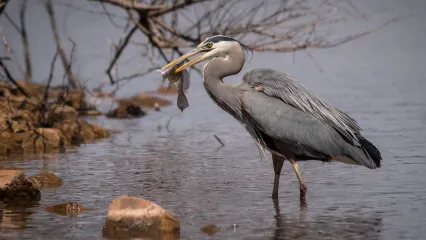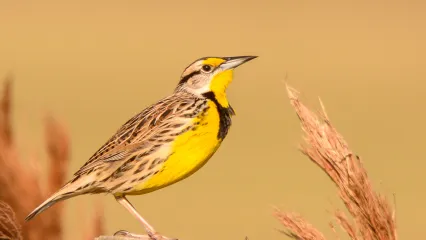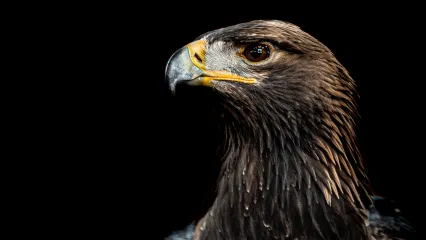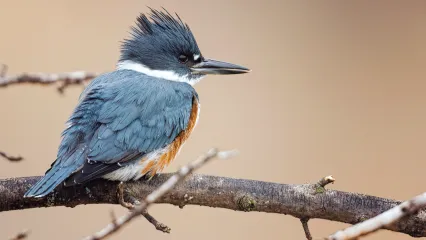
Description
Most Oklahoma outdoor enthusiasts are quite familiar with the great blue heron (Ardea herodius) The largest and most widely distributed heron in North America. the great blue heron is one of Oklahoma's largest birds. Though generally slate blue in appearance, the great blue heron also has patches of light to grayish feathers on the breast and shoulder areas. The forehead and the top of the head are white, with the crown, crest and legs black.
Great blue herons live near marshes, swamps, rivers and lakes. Found from southeast Alaska throughout North America to Mexico, the Galapagos Islands, and the West Indies, the great blue heron is a year-round resident in Oklahoma. Overhead, great blue herons fly with slow wing beats, their legs held straight back with their necks back to the shoulder in an "S" curve. Flight appears to be slow, but these birds are capable of reaching speeds of up to 35 miles per hour.
Both male and female have long plumes on their head, neck, and back during the breeding season. To attract the female, the male performs a variety of displays, such as stretching its neck forward with its head and neck feathers erect, then snapping its bill shut, or flying in a circle above the nesting area with its neck extended.
Whether you are out fishing, hunting or just out spending time outdoors. take a moment to enjoy the graceful beauty of the great blue heron
Size
It can weigh anywhere from five to eight pounds and stand about four feet tall. Their wings are deeply curved with a massive wingspan of close to six feet.
Habitat
You can see this heron in Oklahoma along streams. ponds. and lakes. The bird stands in the shallows not moving a muscle until the split second its prey comes within striking distance. The great blue heron feeds mostly in the daytime, especially at dawn and dusk. It feeds primarily on fish and insects, however, the heron also can dine on frogs, salamanders, turtles, and small water birds and will hunt on land for snakes, and small mammals and birds.
Life Cycle
In Oklahoma, nesting takes place from March through June, depending on location. When building a nest alongside others of their species, the male gathers the nesting material, and the female uses its bill to work it into the nest. Newly built nests are often flimsy and relatively small, about 18 inches across. Older nests are more substantial because they are expanded and used repeatedly, some reaching three to four feet across. The normal clutch size is three to four. The light bluish-green to pale olive eggs hatch after about four weeks of incubation.
The young leave the nest in late spring or early summer. Both parents feed the chicks, and upon reaching the nest, the parents are greeted with sounds that resemble the barking of puppies. This causes them to regurgitate the food into the young herons' open bills. The rate of feeding declines as the nestlings mature. The juvenile birds begin flying and foraging around two months of age. The youngsters remain gray all over with dark crowns until the fall of their third year when they attain adult plumage with some immature characteristics possibly being retained.


